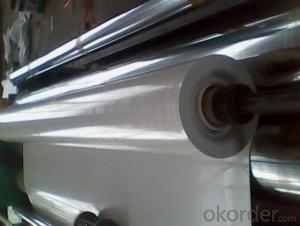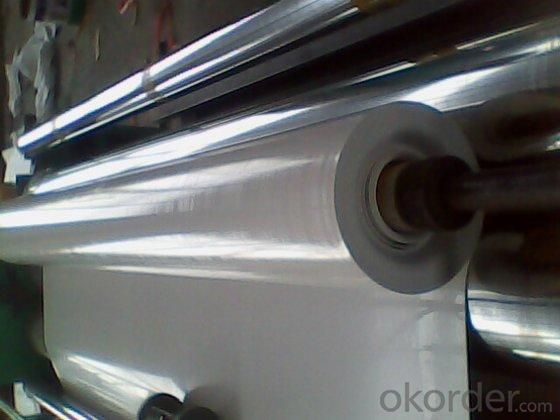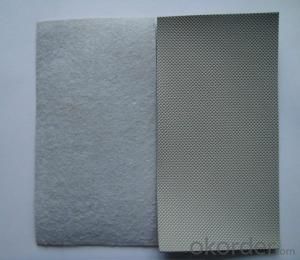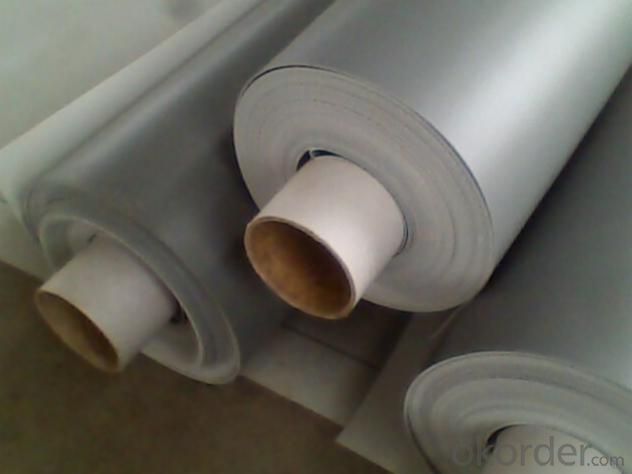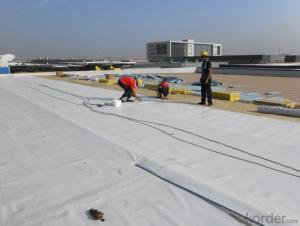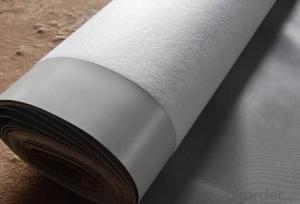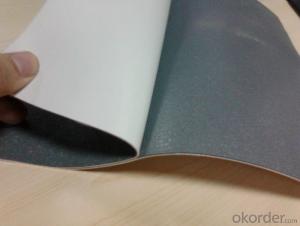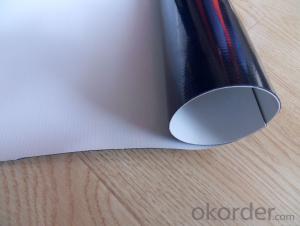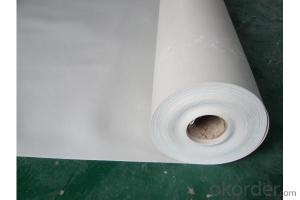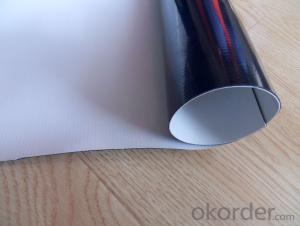PVC Waterproofing Sheets with Fiberglass Reinforcement in Color Grey
- Loading Port:
- Shanghai
- Payment Terms:
- TT OR LC
- Min Order Qty:
- 20000 m²
- Supply Capability:
- 5000000 m²/month
OKorder Service Pledge
OKorder Financial Service
You Might Also Like
PVC Waterproofing Sheets with Fiberglass Reinforcement in Color Grey
Product Description of PVC Waterproofing Sheets with Fiberglass Reinforcement in Color Grey:
PVC Membrane Waterproof /Waterproofing membrane For Roof is a new polymer waterproof membrane. The PVC Membrane Waterproof /Waterproofing membrane For Roof raw material is polyvinyl chloride resin, mixed with plasticizer, filler, antioxygen, ultraviolet absorber and other auxiliaries.
Thickness: 1.2mm/1.5mm/1.8mm/2.0mm
Width:2050mm
Length:20m( Special specifications can be customized)
Size: 2.05mx20m
Color: white/grey, or any other colors.
Features of PVC PVC Waterproofing Sheets with Fiberglass Reinforcement in Color Grey:
1. Excellent anti-aging property.
2. Puncture- resistant.
3. Welding construction,
4. High tensile strength, good elongation, good dimensional stability.
5. Good plasticity.
6. It has self-extinguishing from fire property.
7. Materials surface is smooth, fast color, stain resistance.
8. More wide, Wastage become less when being used.
Classification of PVC Waterproofing Sheets with Fiberglass Reinforcement in Color Grey:
1. N: Homogeneous PVC membrane
2. L: PVC membrane with fabric backing
3. W: Reinforced PVC membrane
Advantage of PVC Waterproofing Sheets with Fiberglass Reinforcement in Color Grey:
1.) Mixing automation. Apply automatic temperature control automatic time control and automatic feed control.
2.) Extrusion equipment uses twin screw coextrusion. Screw temperature uses computer automatic temperature control system.
3.) Handpiece uses large width didhead extrusion equipment.
4.) Sophisticated three-roller calender equipment. The space between equiment is controlled by automation system.
Technical Data of PVC Waterproofing Sheets with Fiberglass Reinforcement in Color Grey:
No. | Item | Model Ⅱ | |
1 | Tensile Strength Mpa ≥ | 12.0 | |
2 | Elongation at break% ≥ | 250 | |
3 | Shrinkage rate % ≤ | 2.0 | |
4 | Flexibility at low temperature | No crackle at -25oC | |
5 | Water tightness | Watertight | |
6 | Puncture resistance | Watertight | |
7 | Heat aging treatment | Appearance | Free from bubble, crack, cohesion and void |
Change rate of tensile strength % | +20oC | ||
Change rate of elongation at break | |||
Flexibility at low temperature | No crack at -20oC | ||
8 | Chemical corrosion resistance | Change rate of tensile strength % | +20 |
Change rate of elongation at break | |||
Flexibility at low temperature | No crack at -20oC | ||
9 | Artificial weathering | Change rate of tensile strength % | +20 |
Change rate of elongation at break | |||
Flexibility at low temperature | No crack at -20oC | ||
Application of PVC Waterproofing Sheets with Fiberglass Reinforcement in Color Grey:
1) All kinds of roofs, such as steel structure roof, planted roof etc.
2) Underground engineering, such as building basement, subways, tunnels, air raid shelter, etc.
3) Other projects like artificial lake, dam, water reservoir, grain storehouse, etc.
Images of PVC Waterproofing Sheets with Fiberglass Reinforcement in Color Grey:
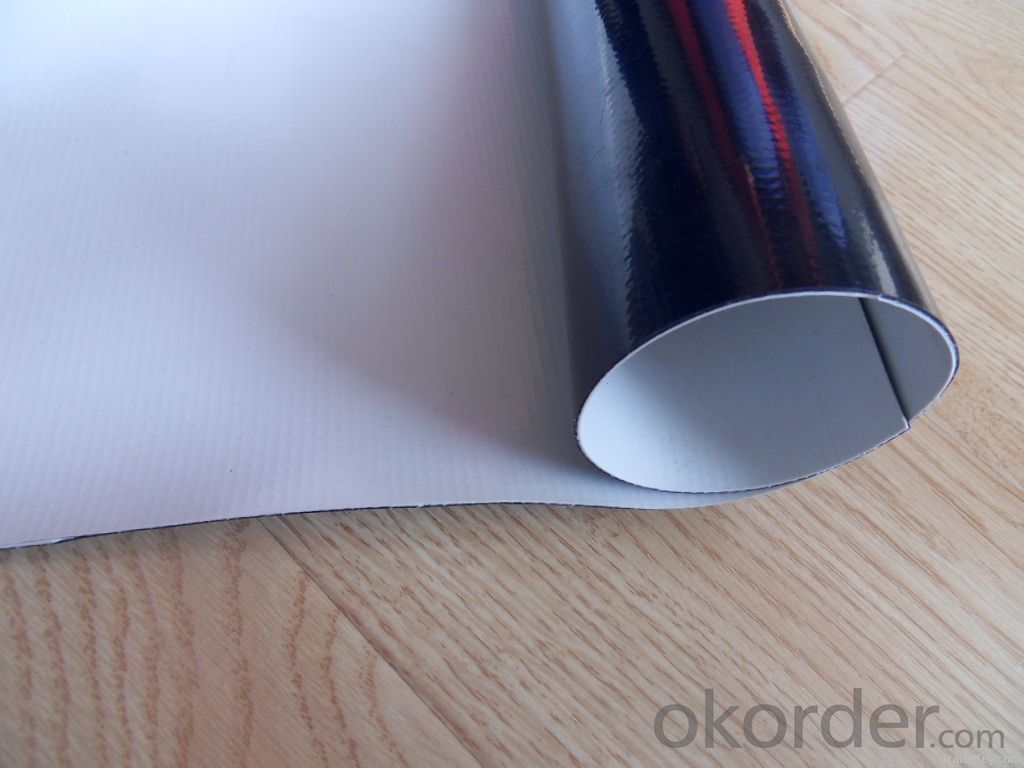
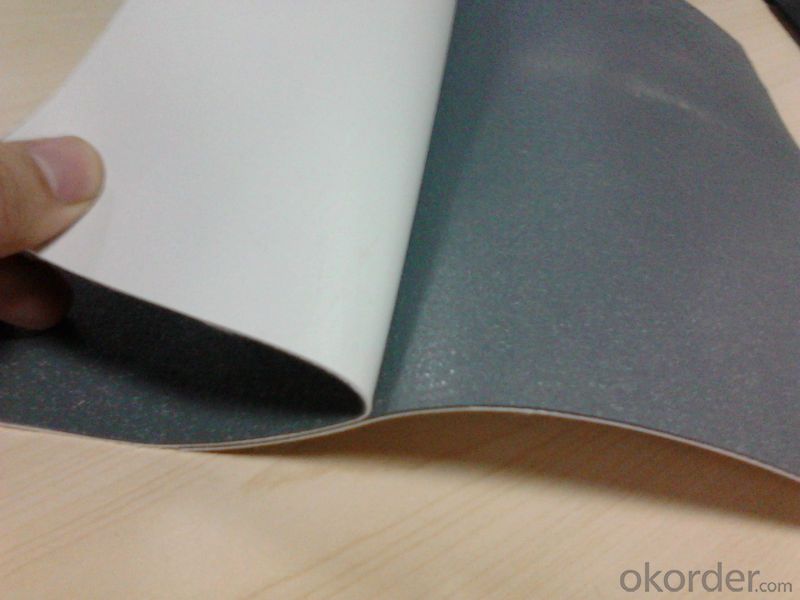
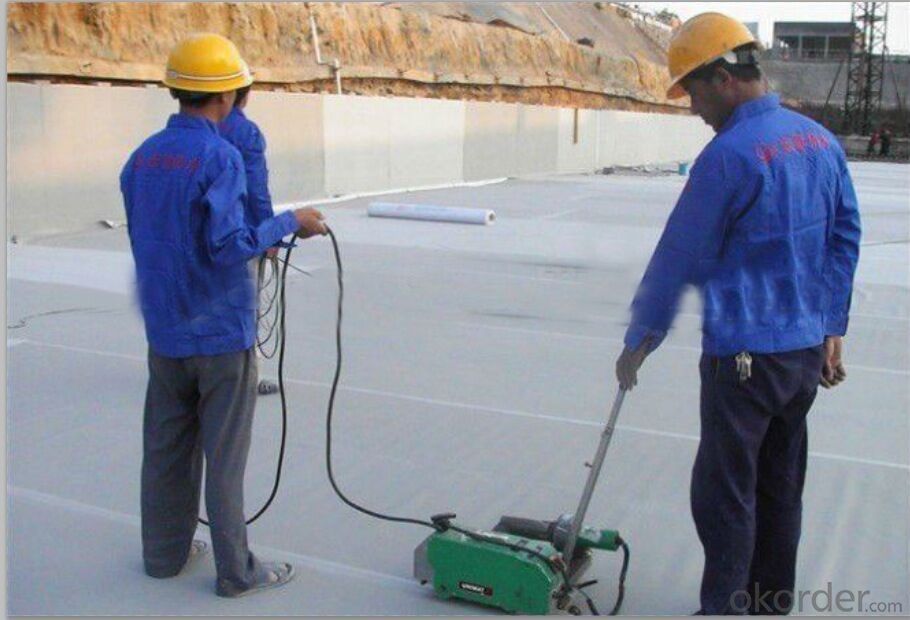
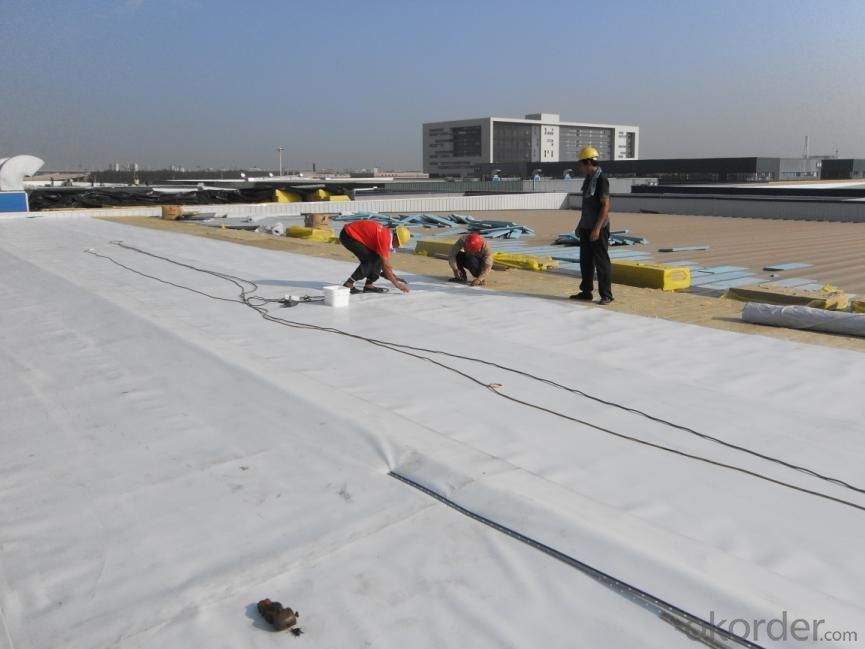
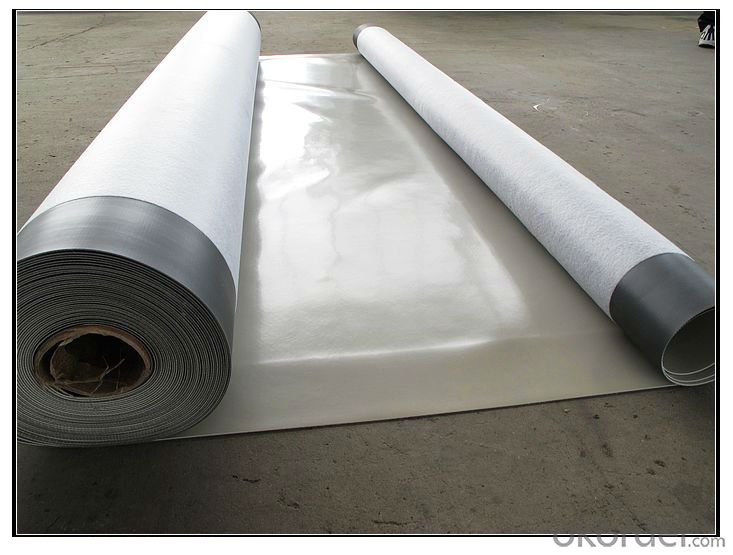
FAQ:
1. Can you produce 4m width?
Yes, no problem for us. We have four bases in China, largest one in this field.
2. How many quantity in one 20'' container for 1.2mm and 1.5mm?
480rolls, 11520m2 for 1.2mm and 400rolls, 9600m2 for 1.5mm
3. Can you provide free samples?
Yes, our samples are free, but express fees usually on buyer's account.
- Q: Does a waterproofing membrane have any impact on the indoor air quality?
- Yes, a waterproofing membrane can have an impact on indoor air quality. Waterproofing membranes are commonly used to prevent water infiltration into buildings, especially in areas prone to moisture, such as basements, roofs, and foundations. These membranes are typically made of synthetic materials, such as polyethylene or polypropylene, which can release volatile organic compounds (VOCs) into the air. VOCs are chemicals that can evaporate at room temperature and can have adverse effects on indoor air quality. When released into the air, VOCs can contribute to the formation of indoor air pollutants, such as formaldehyde or benzene. Prolonged exposure to VOCs can cause various health issues, including eye, nose, and throat irritation, headaches, dizziness, and even respiratory problems. However, it is important to note that not all waterproofing membranes have the same impact on indoor air quality. Some manufacturers have developed low VOC or VOC-free waterproofing membranes, which are designed to minimize the release of harmful chemicals into the air. These products undergo rigorous testing to ensure they meet stringent air quality standards. Additionally, proper installation and ventilation can also play a significant role in mitigating any potential negative impact on indoor air quality. Adequate ventilation systems can help remove any VOCs or other pollutants from the air, preventing them from accumulating and causing health issues. Therefore, when considering the installation of a waterproofing membrane, it is crucial to select a product that has been tested for low VOC emissions and to ensure proper ventilation is in place to maintain good indoor air quality. Consulting with professionals in the field can provide valuable guidance in choosing the most appropriate waterproofing solution for your specific needs while minimizing any potential impact on indoor air quality.
- Q: Can a waterproofing membrane be used in mining or excavation projects?
- Yes, a waterproofing membrane can be used in mining or excavation projects. Waterproofing membranes are designed to prevent the ingress of water and other liquids, making them an ideal solution for areas that are prone to water intrusion, such as mines or excavations. These membranes are typically made from durable materials, such as rubber or bitumen, and are applied to the walls, floors, or roofs of these structures to create a watertight barrier. By using a waterproofing membrane, mining and excavation projects can minimize the risk of water damage, protect equipment and infrastructure, and ensure a safe working environment for workers.
- Q: Can a waterproofing membrane be used for a foundation wall damp proofing?
- Yes, a waterproofing membrane can be used for foundation wall damp proofing. A waterproofing membrane is designed to prevent the passage of water and can be used to create a barrier between the foundation wall and the surrounding soil. This barrier can help to prevent moisture from seeping into the foundation wall, which can lead to dampness and potential water damage. By applying a waterproofing membrane to the foundation wall, it can effectively damp proof the wall and protect it from water intrusion. However, it is important to ensure that the waterproofing membrane is installed correctly and that all joints and seams are properly sealed to provide a continuous barrier against water.
- Q: Can a waterproofing membrane be used for loading docks or ramps?
- Yes, a waterproofing membrane can be used for loading docks or ramps. Waterproofing membranes are designed to protect surfaces from water damage and can provide an effective barrier against water penetration. Using a waterproofing membrane on loading docks or ramps can help prevent water seepage and potential structural damage, providing added durability and longevity to the surfaces.
- Q: Can a waterproofing membrane improve energy efficiency?
- Indeed, energy efficiency can be enhanced through the utilization of a waterproofing membrane. By functioning as a barricade against the infiltration of moisture, the waterproofing membrane effectively averts water from permeating the building envelope. Consequently, it maintains the structure's dryness, thus inhibiting the growth of mold and mildew. This is pivotal in the preservation of indoor air quality and the safeguarding of building materials from deterioration. Furthermore, a waterproofing membrane can also offer insulation advantages. Numerous waterproofing membranes are engineered with a substantial thermal resistance, commonly referred to as R-value. This signifies that they can furnish an additional layer of insulation to the edifice, diminishing heat transfer across the walls and roof. By enhancing the thermal performance of the building, a waterproofing membrane facilitates the reduction of the burden placed on heating and cooling systems, ultimately leading to energy savings and improved energy efficiency. Moreover, a waterproofing membrane can contribute to the reduction of air leakage within a building. Air leakage is responsible for a noteworthy amount of energy dissipation, as conditioned air escapes through crevices and fissures in the building envelope. By effectively sealing off these areas, the waterproofing membrane aids in enhancing the airtightness of the building, thereby diminishing energy loss and improving energy efficiency. All in all, a waterproofing membrane assumes a pivotal role in the enhancement of energy efficiency by preventing moisture intrusion, providing supplementary insulation, and diminishing air leakage. Allocating resources towards a top-notch waterproofing system can result in long-term energy savings, improved indoor comfort, and a more sustainable and efficient building.
- Q: Can a waterproofing membrane be used in bathrooms?
- Yes, a waterproofing membrane can be used in bathrooms. In fact, it is highly recommended to use a waterproofing membrane in bathrooms to prevent water damage and leakage. The membrane acts as a barrier, preventing moisture from seeping into the walls or floors, ensuring the longevity and durability of the bathroom.
- Q: Can a waterproofing membrane be used in hospitals or healthcare facilities?
- Yes, a waterproofing membrane can be used in hospitals or healthcare facilities. In fact, it is highly recommended to use waterproofing membranes in these settings due to the critical need for maintaining a clean and hygienic environment. Waterproofing membranes are typically applied on floors, walls, and ceilings to prevent water or moisture infiltration, which can lead to mold growth, deterioration of building materials, and compromise the structural integrity of the facility. By using waterproofing membranes, healthcare facilities can effectively protect against water damage, facilitate easier cleaning and maintenance, and prevent the growth of bacteria and other harmful microorganisms. Additionally, waterproofing membranes can also help in managing moisture levels, thereby reducing the risk of slips and falls, which is especially crucial in areas where patients, staff, and visitors frequent. Overall, waterproofing membranes are a valuable asset in ensuring the safety, durability, and cleanliness of hospitals and healthcare facilities.
- Q: Can a waterproofing membrane be used in crawl spaces?
- Crawl spaces, being susceptible to moisture and water intrusion, can suffer from issues like mold, mildew, and structural damage. For protection against water damage, using a waterproofing membrane is an effective solution. By installing the membrane on the walls and floor of the crawl space, it creates a barrier that keeps moisture out. This is especially useful in areas with high water table levels or frequent flooding. Moreover, the waterproofing membrane not only safeguards the crawl space but also enhances indoor air quality by inhibiting mold growth and reducing allergens. To determine the most suitable waterproofing membrane and installation method for a specific crawl space, it is advisable to seek professional advice as requirements may differ.
- Q: Can a waterproofing membrane be used for pond or pool applications?
- Certainly! A waterproofing membrane is suitable for both pond and pool applications. Its main purpose is to create a barrier that prevents water from penetrating, making it an excellent choice for sealing ponds and pools. These membranes are typically made from synthetic materials like PVC, EPDM, or TPO, all of which have high resistance to water and UV rays. They come in different thicknesses and can be tailored to fit the specific dimensions of the pond or pool. Moreover, waterproofing membranes are incredibly durable and flexible, allowing them to withstand continuous exposure to water and the movement of the underlying substrate. In summary, utilizing a waterproofing membrane for pond or pool applications helps avoid leaks, extends the lifespan of the structure, and guarantees a safe and enjoyable water environment.
- Q: Can a waterproofing membrane be used on vinyl surfaces?
- Yes, a waterproofing membrane can be used on vinyl surfaces. The membrane serves as a protective layer that prevents water from penetrating and damaging the vinyl material.
Send your message to us
PVC Waterproofing Sheets with Fiberglass Reinforcement in Color Grey
- Loading Port:
- Shanghai
- Payment Terms:
- TT OR LC
- Min Order Qty:
- 20000 m²
- Supply Capability:
- 5000000 m²/month
OKorder Service Pledge
OKorder Financial Service
Similar products
Hot products
Hot Searches
Related keywords
